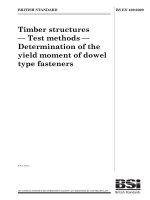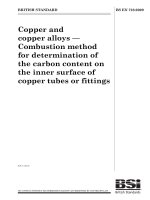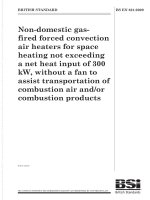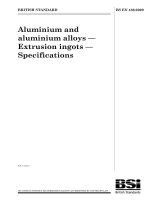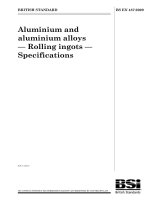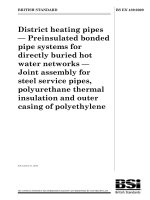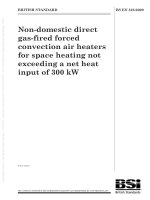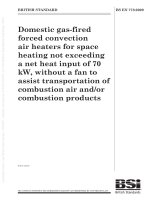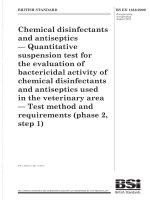Bsi bs en 61984 2009
Bạn đang xem bản rút gọn của tài liệu. Xem và tải ngay bản đầy đủ của tài liệu tại đây (1.87 MB, 52 trang )
BS EN 61984:2009
BSI British Standards
Connectors — Safety
requirements and tests
NO COPYING WITHOUT BSI PERMISSION EXCEPT AS PERMITTED BY COPYRIGHT LAW
raising standards worldwide™
BRITISH STANDARD
BS EN 61984:2009
National foreword
This British Standard is the UK implementation of EN 61984:2009. It is identical to IEC 61984:2008. It supersedes BS EN 61984:2001 which is withdrawn.
The UK participation in its preparation was entrusted to Technical Committee
EPL/48, Electromechanical components and mechanical structures for electronic equipment.
A list of organizations represented on this committee can be obtained on
request to its secretary.
This publication does not purport to include all the necessary provisions of a
contract. Users are responsible for its correct application.
© BSI 2009
ISBN 978 0 580 55007 2
ICS 31.220.10
Compliance with a British Standard cannot confer immunity from
legal obligations.
This British Standard was published under the authority of the Standards
Policy and Strategy Committee on 31 July 2009
Amendments issued since publication
Amd. No.
Date
标准分享网 www.bzfxw.com 免费下载
Text affected
BS EN 61984:2009
EUROPEAN STANDARD
EN 61984
NORME EUROPÉENNE
EUROPÄISCHE NORM
June 2009
ICS 31.220.10
Supersedes EN 61984:2001
English version
Connectors Safety requirements and tests
(IEC 61984:2008)
Connecteurs Exigences de sécurité et essais
(CEI 61984:2008)
Steckverbinder Sicherheitsanforderungen und Prüfungen
(IEC 61984:2008)
This European Standard was approved by CENELEC on 2009-06-01. CENELEC members are bound to comply
with the CEN/CENELEC Internal Regulations which stipulate the conditions for giving this European Standard
the status of a national standard without any alteration.
www.bzfxw.com
Up-to-date lists and bibliographical references concerning such national standards may be obtained on
application to the Central Secretariat or to any CENELEC member.
This European Standard exists in three official versions (English, French, German). A version in any other
language made by translation under the responsibility of a CENELEC member into its own language and notified
to the Central Secretariat has the same status as the official versions.
CENELEC members are the national electrotechnical committees of Austria, Belgium, Bulgaria, Cyprus, the
Czech Republic, Denmark, Estonia, Finland, France, Germany, Greece, Hungary, Iceland, Ireland, Italy, Latvia,
Lithuania, Luxembourg, Malta, the Netherlands, Norway, Poland, Portugal, Romania, Slovakia, Slovenia, Spain,
Sweden, Switzerland and the United Kingdom.
CENELEC
European Committee for Electrotechnical Standardization
Comité Européen de Normalisation Electrotechnique
Europäisches Komitee für Elektrotechnische Normung
Central Secretariat: Avenue Marnix 17, B - 1000 Brussels
© 2009 CENELEC -
All rights of exploitation in any form and by any means reserved worldwide for CENELEC members.
Ref. No. EN 61984:2009 E
BS EN 61984:2009
EN 61984:2009
–2–
Foreword
The text of document 48B/1927/FDIS, future edition 2 of IEC 61984, prepared by SC 48B, Connectors, of
IEC TC 48, Electromechanical components and mechanical structures for electronic equipment, was
submitted to the IEC-CENELEC parallel vote and was approved by CENELEC as EN 61984 on
2009-06-01.
This European Standard supersedes EN 61984:2001.
EN 61984:2009 includes the following significant technical changes with respect to EN 61984:2001:
– addition in the scope of the statement that this standard may be used as a guide for connectors with
rated current higher than 125 A per pole;
– new definitions added and improvement of existing definitions;
– in Clause 5, the classification referred to protection against electric shock and that of connector for
class II equipment were added;
– in 6.4 (Protection against electric shock), it is clarified that all parts which are necessary to ensure
protection against electric shock shall only be removable by the aid of a tool;
– Table 2 and Table 3 are added for better readability and connecting methods updated to current status
of standardization;
– values for cable clamp testing in Table 6 are adopted according to EN 50262 and no tests are required
if metric cable glands according to this standard are used;
– tables in 6.19 are deleted and the text refers to EN 60664;
www.bzfxw.com
– Table 7 (Values for torque for screw-type clamping units) in 7.1.4 of EN 61984:2001 is deleted and the
text refers to the relevant standards;
– Subclause 7.3.7 of EN 61984:2001 is modified. In 7.3.8 of EN 61984:2009, the length of the
connecting cable and conductor loops are added. Test arrangements for temperature rise test for
two-part printed board connectors are fixed;
– Figure 2 (Device for bending test) transferred from 7.3.8 (Mechanical operation) of EN 61984:2001 to
7.3.10 (Bending (flexing) test) of EN 61984:2009;
– in Table 10 (Mechanical test group A) test phase A3, the severity or conditions for unenclosed and
enclosed connectors are specified;
– the informative Annex B (Additional information on connector classification) with its Tables B.1
(Scheme of connectors) and B.2 (Help for the classification of connectors) are added for better
readability of the standard.
The following dates were fixed:
– latest date by which the EN has to be implemented
at national level by publication of an identical
national standard or by endorsement
(dop)
2010-03-01
– latest date by which the national standards conflicting
with the EN have to be withdrawn
(dow)
2012-06-01
Annex ZA has been added by CENELEC.
__________
标准分享网 www.bzfxw.com 免费下载
–3–
BS EN 61984:2009
EN 61984:2009
Endorsement notice
The text of the International Standard IEC 61984:2008 was approved by CENELEC as a European
Standard without any modification.
In the official version, for Bibliography, the following notes have to be added for the standards indicated:
IEC 60068-2-20 + A2
NOTE Harmonized as HD 323.2.20 S3:1988 (not modified).
IEC 60112
NOTE Harmonized as EN 60112:2003 (not modified).
IEC 60364-5-54
NOTE Harmonized as HD 60364-5-54:2007 (modified).
IEC 60423
NOTE Harmonized as EN 60423:2007 (not modified).
IEC 60695-2-12
NOTE Harmonized as EN 60695-2-12:2001 (not modified).
IEC 60695-10-2
NOTE Harmonized as EN 60695-10-2:2003 (not modified).
IEC 60695-11-5
NOTE Harmonized as EN 60695-11-5:2005 (not modified).
IEC 60998-2-1
NOTE Harmonized as EN 60998-2-1:2002 (modified).
IEC 60998-2-2
NOTE Harmonized as EN 60998-2-2:2002 (modified).
__________
www.bzfxw.com
BS EN 61984:2009
EN 61984:2009
–4–
Annex ZA
(normative)
Normative references to international publications
with their corresponding European publications
The following referenced documents are indispensable for the application of this document. For dated
references, only the edition cited applies. For undated references, the latest edition of the referenced
document (including any amendments) applies.
NOTE When an international publication has been modified by common modifications, indicated by (mod), the relevant EN/HD
applies.
Publication
Year
Title
EN/HD
Year
-
-
Cable glands for electrical installations
EN 50262
+ corr. October
A1
A2
1998
1998
2001
2004
IEC 60050-581
-
1)
International Electrotechnical Vocabulary
(IEV) Part 581: Electromechanical components for
electronic equipment
-
IEC 60050-826
-
1)
International Electrotechnical Vocabulary
(IEV) Part 826: Electrical installations
-
-
IEC 60060-1
-
1)
High-voltage test techniques Part 1: General definitions and test
requirements
HD 588.1 S1
1991
2)
-
1)
Environmental testing Part 1: General and guidance
EN 60068-1
1994
2)
IEC 60068-2-70
-
1)
Environmental testing EN 60068-2-70
Part 2: Tests - Test Xb: Abrasion of markings
and letterings caused by rubbing of fingers
and hands
1996
2)
IEC 60228
2004
Conductors of insulated cables
EN 60228
+ corr. May
2005
2005
IEC 60309-1
A1 (mod)
1999
2005
Plugs, socket-outlets and couplers for
industrial purposes Part 1: General requirements
EN 60309-1
A1
1999
2007
IEC 60352-1
-
1)
Solderless connections Part 1: Wrapped connections - General
requirements, test methods and practical
guidance
EN 60352-1
1997
2)
IEC 60352-2
-
1)
Solderless connections Part 2: Crimped connections - General
requirements, test methods and practical
guidance
EN 60352-2
2006
2)
IEC 60352-3
1993
Solderless connections Part 3: Solderless accessible insulation
displacement connections - General
requirements, test methods and practical
guidance
EN 60352-3
1994
IEC 60068-1
1)
2)
www.bzfxw.com
Undated reference.
Valid edition at date of issue.
标准分享网 www.bzfxw.com 免费下载
BS EN 61984:2009
EN 61984:2009
–5–
Publication
Year
Title
EN/HD
Year
IEC 60352-4
1994
Solderless connections Part 4: Solderless non-accessible insulation
displacement connections - General
requirements, test methods and practical
guidance
EN 60352-4
1994
IEC 60352-5
-
1)
Solderless connections Part 5: Press-in connections - General
requirements, test methods and practical
guidance
EN 60352-5
2008
2)
IEC 60352-6
-
1)
Solderless connections Part 6: Insulation piercing connections General requirements, test methods and
practical guidance
EN 60352-6
1997
2)
IEC 60352-7
-
1)
Solderless connections Part 7: Spring clamp connections - General
requirements, test methods and practical
guidance
EN 60352-7
2002
2)
IEC 60364-4-41
(mod)
-
1)
Low-voltage electrical installations Part 4-41: Protection for safety - Protection
against electric shock
HD 60364-4-41
+ corr. July
2007
2007
2)
IEC 60417
Database
Graphical symbols for use on equipment
-
-
IEC 60512
Series Connectors for electronic equipment - Tests
and measurements
EN 60512
Series
www.bzfxw.com
1)
IEC 60512-1-100
-
IEC 60529
1989
Connectors for electronic equipment - Tests EN 60512-1-100
and measurements Part 1-100: General - Applicable publications
2006
Degrees of protection provided by
enclosures (IP Code)
EN 60529
+ corr. May
A1
1991
1993
2000
A1
1999
IEC 60664-1
2007
Insulation coordination for equipment within
low-voltage systems Part 1: Principles, requirements and tests
EN 60664-1
2007
IEC 60664-5
2007
Insulation coordination for equipment within
low-voltage systems Part 5: Comprehensive method for
determining clearances and creepage
distances equal to or less than 2 mm
EN 60664-5
2007
IEC 60760
-
Flat, quick-connect terminations
-
-
IEC 60998-2-3
(mod)
2002
Connecting devices for low-voltage circuits
for household and similar purposes Part 2-3: Particular requirements for
connecting devices as separate entities with
insulation-piercing clamping units
EN 60998-2-3
2004
IEC 60999-1
1999
Connecting devices - Electrical copper
EN 60999-1
conductors - Safety requirements for
screw-type and screwless-type clamping
units Part 1: General requirements and particular
requirements for clamping units for conductors
from 0,2 mm² up to 35 mm² (included)
1)
2000
2)
BS EN 61984:2009
EN 61984:2009
–6–
Publication
Year
Title
EN/HD
Year
IEC 60999-2
2003
Connecting devices - Electrical copper
conductors - Safety requirements for
screw-type and screwless-type clamping
units Part 2: Particular requirements for clamping
units for conductors above 35 mm² up to
300 mm² (included)
EN 60999-2
2003
IEC 61032
-
1)
Protection of persons and equipment by
enclosures - Probes for verification
EN 61032
1998
2)
IEC 61140
-
1)
Protection against electric shock - Common
aspects for installation and equipment
EN 61140
2002
2)
IEC 61210
(mod)
-
1)
Connecting devices - Flat quick-connect
EN 61210
terminations for electrical copper conductors Safety requirements
1995
2)
ISO 6988
1985
Metallic and other non-organic coatings EN ISO 6988
Sulfur dioxide test with general condensation
of moisture
1994
www.bzfxw.com
标准分享网 www.bzfxw.com 免费下载
BS EN 61984:2009
–2–
61984 © IEC:2008
CONTENTS
1
Scope ...............................................................................................................................7
2
Normative references .......................................................................................................7
3
Terms and definitions .......................................................................................................9
4
Technical information (electrical ratings) ........................................................................ 14
5
Classification .................................................................................................................. 14
6
5.1 General ................................................................................................................. 14
5.2 Classification according to protection against electric shock .................................. 14
5.3 Classification according to the style of connector .................................................. 14
5.4 Classification according to additional characteristics of connectors ....................... 14
Constructional requirements and performance ................................................................ 15
6.1
6.2
6.3
6.4
6.5
6.6
6.7
6.8
6.9
6.10
6.11
6.12
6.13
6.14
6.15
General ................................................................................................................. 15
Marking and identification...................................................................................... 15
6.2.1 Identification .............................................................................................. 15
6.2.2 Marking ..................................................................................................... 15
6.2.3 Marking of position for contacts ................................................................. 16
Provision against incorrect mating (non-intermateable) ......................................... 16
Protection against electric shock ........................................................................... 17
6.4.1 Non accessibility of live parts .................................................................... 17
6.4.2 Non applicability of protection requirement to unenclosed connectors........ 17
6.4.3 Protection against electric shock during insertion and withdrawal .............. 17
Provisions for earthing .......................................................................................... 17
6.5.1 First make, last break PE contact ............................................................. 17
6.5.2 PE contacts on connector for class II equipment........................................ 17
6.5.3 Reliability of connection to PE contacts ..................................................... 18
6.5.4 Connection of the protective conductor ...................................................... 18
Terminations and connection methods................................................................... 18
6.6.1 General ..................................................................................................... 18
6.6.2 Type and range of conductor cross-sectional areas ................................... 20
6.6.3 Design of electrical connections ................................................................ 20
Interlock ................................................................................................................ 20
Resistance to ageing ............................................................................................. 20
General design ...................................................................................................... 20
6.9.1 Polarisation ............................................................................................... 20
6.9.2 Fixing of live parts ..................................................................................... 20
6.9.3 Connection of conductors .......................................................................... 20
6.9.4 Design of non rewirable connectors ........................................................... 20
Design of a CBC.................................................................................................... 21
Design of a free connector .................................................................................... 21
Degree of protection (IP Code) .............................................................................. 21
Dielectric strength ................................................................................................. 21
Mechanical and electrical durability ....................................................................... 21
6.14.1 Mechanical endurance (COC and CBC) ..................................................... 21
6.14.2 Electrical endurance (CBC) ....................................................................... 21
6.14.3 Bendings (non-rewirable connectors) ......................................................... 21
Temperature limits ................................................................................................ 22
www.bzfxw.com
BS EN 61984:2009
61984 © IEC:2008
7
–3–
6.16 Temperature rise ................................................................................................... 23
6.17 Cable clamp .......................................................................................................... 23
6.18 Mechanical strength .............................................................................................. 23
6.18.1 Robustness of connectors ......................................................................... 23
6.18.2 Retention of contacts ................................................................................. 23
6.18.3 Integrity of internal insulation..................................................................... 24
6.19 Clearances and creepage distances ...................................................................... 24
6.19.1 Clearances ................................................................................................ 24
6.19.2 Creepage distances ................................................................................... 24
6.20 Insulation .............................................................................................................. 25
6.20.1 Functional and basic insulation .................................................................. 25
6.20.2 Supplementary insulation .......................................................................... 25
6.20.3 Double insulation ....................................................................................... 25
6.20.4 Reinforced insulation ................................................................................. 25
6.21 Protection against corrosion .................................................................................. 25
Tests .............................................................................................................................. 26
7.1
7.2
7.3
7.4
General ................................................................................................................. 26
7.1.1 Test sequence and number of specimens .................................................. 26
7.1.2 Specimens condition.................................................................................. 26
7.1.3 Atmospheric conditions.............................................................................. 26
7.1.4 Number of specimens for tests on terminations ......................................... 26
7.1.5 Failure criteria ........................................................................................... 26
7.1.6 Visual examination tests ............................................................................ 26
Preparation of specimens ...................................................................................... 26
7.2.1 Pre-conditioning ........................................................................................ 26
7.2.2 Conductors ................................................................................................ 26
7.2.3 Torque for screw-type clamping units ........................................................ 27
7.2.4 Assembly conditions .................................................................................. 27
Performance of tests ............................................................................................. 27
7.3.1 General ..................................................................................................... 27
7.3.2 Durability of marking.................................................................................. 27
7.3.3 “First make, last break” protective earthing contact.................................... 27
7.3.4 Interlock .................................................................................................... 27
7.3.5 Breaking capacity of a CBC ....................................................................... 27
7.3.6 Protection against electric shock ............................................................... 28
7.3.7 Protection against solid foreign objects and against ingress of water ......... 28
7.3.8 Temperature rise ....................................................................................... 29
7.3.9 Mechanical operation ................................................................................ 31
7.3.10 Bending (flexing) test................................................................................. 31
7.3.11 Measurement of clearances and creepage distances ................................. 33
7.3.12 Dielectric strength ..................................................................................... 33
7.3.13 Resistance between accessible metal parts and the protective
earthing contact......................................................................................... 34
7.3.14 Corrosion test ............................................................................................ 34
In-process test schedule (routine test) for non-rewirable free connectors .............. 34
7.4.1 General ..................................................................................................... 34
7.4.2 Impulse withstand voltage test ................................................................... 34
7.4.3 Continuity of PE path test .......................................................................... 34
7.4.4 AC power-frequency voltage withstand test ............................................... 34
www.bzfxw.com
标准分享网 www.bzfxw.com 免费下载
BS EN 61984:2009
–4–
61984 © IEC:2008
7.5 Test schedule ........................................................................................................ 35
Annex A (informative) Information to be specified in the detail specification, if any, or
manufacturer’s specification ................................................................................................. 41
Annex B (informative) Additional information on connector classification.............................. 43
Bibliography.......................................................................................................................... 45
Figure 1a – Test arrangement for temperature rise test of two-part connectors ..................... 30
Figure 1b – Test arrangement for temperature rise test of two-part connectors on
printed circuit boards ............................................................................................................ 30
Figure 1c – Test arrangement for temperature rise test of edge-socket connectors ............... 31
Figure 1 – Test arrangements for temperature rise tests ....................................................... 31
Figure 2 – Device for the bending test .................................................................................. 32
Table 1 – Minimum cross-sectional area of the protective conductor or the connection
to inactive accessible metal parts ......................................................................................... 18
Table 2 – Compliant termination and connection methods..................................................... 19
Table 3 – Tests on connections and terminations.................................................................. 19
Table 4 – Mechanical and electrical durability ....................................................................... 22
Table 4a – Operating cycles – Preferred values .................................................................... 22
Table 4b – Bendings –Preferred values ................................................................................ 22
www.bzfxw.com
Table 5 – Temperature limits ................................................................................................ 22
Table 5a – Lower limiting temperature (LLT) – Preferred values ........................................... 22
Table 5b – Upper limiting temperature (ULT) – Preferred values ........................................... 22
Table 6 – Values for cable clamp testing............................................................................... 23
Table 7 – Length of the connecting cable and conductor loops ............................................. 29
Table 8 – Test voltages......................................................................................................... 33
Table 9 – Plan of specimens required for tests...................................................................... 35
Table 10 – Mechanical test group A ...................................................................................... 35
Table 11 – Service life test group B ...................................................................................... 37
Table 12 – Thermal test group C........................................................................................... 38
Table 13 – Climatic test group D ........................................................................................... 39
Table 14 – Degree of protection, test group E ....................................................................... 40
Table B.1 – Scheme of connectors........................................................................................ 43
Table B.2 – Help for the classification of connectors ............................................................. 44
BS EN 61984:2009
61984 © IEC:2008
–7–
CONNECTORS –
SAFETY REQUIREMENTS AND TESTS
1
Scope
This International Standard applies to connectors with rated voltages above 50 V and up to
1000 V a.c. and d.c. and rated currents up to 125 A per contact, for which either no detail
specification (DS) exists or the DS calls up this standard for safety aspects.
For connectors with rated voltage up to 50 V, this standard may be used as a guide. In this
case, reference is made to IEC 60664-1 for clearance and creepage distances.
This standard may also be used as a guide for connectors with rated current higher than
125 A per pole.
This standard does not apply to connectors in or on equipment where application specific
safety requirements for connectors exist.
2
Normative references
The following referenced documents are indispensable for the application of this document.
For dated references, only the edition cited applies. For undated references, the latest edition
of the referenced document (including any amendments) applies.
www.bzfxw.com
IEC 60050-581, International Electrotechnical Vocabulary
Electromechanical components for electronic equipment
(IEV)
–
Chapter
581:
IEC 60050-826, International Electrotechnical Vocabulary (IEV) – Chapter 826: Electrical
installations
IEC 60060-1, High-voltage test techniques – Part 1: General definitions and test requirements
IEC 60068-1, Environmental testing – Part 1: General and guidance
IEC 60068-2-70, Environmental testing – Part 2: Tests – Test Xb: Abrasion of marking and
letterings caused by rubbing of fingers and hands
IEC 60228: 2004, Conductors of insulated cables
IEC 60309-1:1999, Plugs, socket-outlets and couplers for industrial purposes – Part 1:
General requirements
Amendment 1 (2005)
IEC 60352-1, Solderless connections – Part 1: Wrapped connections – General requirements,
test methods and practical guidance
IEC 60352-2, Solderless connections – Part 2: Crimped connections – General requirements,
test methods and practical guidance
IEC 60352-3:1993, Solderless connections – Part 3: Solderless accessible insulation
displacement connections – General requirements, test methods and practical guidance
标准分享网 www.bzfxw.com 免费下载
BS EN 61984:2009
–8–
61984 © IEC:2008
IEC 60352-4:1994, Solderless connections – Part 4: Solderless non-accessible insulation
displacement connections – General requirements, test methods and practical guidance
IEC 60352-5, Solderless connections – Part 5: Press-in connections – General requirements,
test methods and practical guidance
IEC 60352-6, Solderless connections – Part 6: Insulation piercing connections – General
requirements, test methods and practical guidance
IEC 60352-7, Solderless connections – Part 7: Spring-clamp connections – General
requirements, test methods and practical guidance
IEC 60364-4-41, Low-voltage electrical installations – Part 4-41: Protection for safety –
Protection against electric shock
IEC 60417, Graphical symbols for use on equipment
IEC 60512 (all parts), Connectors for electronic equipment – Tests and measurements 1
IEC 60512-1-100, Connectors for electronic equipment – Tests and measurements –
Part 1-100: General – Applicable publications
IEC 60529:1989, Degrees of protection provided by enclosures (IP Code)
Amendment 1 (1999)
www.bzfxw.com
IEC 60664-1:2007, Insulation coordination for equipment within low voltage systems – Part 1:
Principles, requirements and tests
IEC 60664-5:2007, Insulation coordination for equipment within low-voltage systems – Part 5:
Comprehensive method for determining clearances and creepage distances equal to or less
than 2 mm
IEC 60760, Flat, quick-connect terminations
IEC 60998-2-3:2002, Connecting devices for low-voltage circuits for household and similar
purposes – Part 2-3: Particular requirements for connecting devices as separate entities with
insulation-piercing clamping units
IEC 60999-1:1999, Connecting devices – Electrical copper conductors – Safety requirements
for screw-type and screwless-type clamping units – Part 1: General requirements and
particular requirements for clamping units for conductors from 0,2 mm 2 up to 35 mm 2
(included)
IEC 60999-2:2003, Connecting devices – Electrical copper conductors – Safety requirements
for screw-type and screwless-type clamping units – Part 2: Particular requirements for
conductors above 35 up to 300 mm 2 (included)
IEC 61032, Protection of persons and equipment by enclosures – Probes for verification
IEC 61140, Protection against electric shock – Common aspects for installation and
equipment
—————————
1 IEC 60512-1-100 gives the list of tests of the IEC 60512 series and the part of IEC 60512 corresponding to
each test.
BS EN 61984:2009
61984 © IEC:2008
–9–
IEC 61210, Connecting devices – Flat quick-connect terminations for electrical copper
conductors – Safety requirements
ISO 6988:1985, Metallic and other non organic coatings – Sulfur dioxide test with general
condensation of moisture
EN 50262:1998, Cable glands for electrical installations
Amendment 1 (2001)
Amendment 2 (2004)
3
Terms and definitions
For the purpose of this International Standard, definitions from IEC 60050-581,
IEC 60050-826, IEC 60309-1, IEC 60664-1, IEC 60999-1 and IEC 61140, as well as the
following, apply.
3.1
connector
component which terminates conductors for the purpose of providing connection to and
disconnection from a suitable mating component
[IEV 581-06-01, modified]
3.2
free connector
connector for attachment to the free end of a wire or cable
www.bzfxw.com
[IEV 581-06-12]
3.3
fixed connector
connector for attachment to a rigid surface
[IEV 581-06-10]
3.4
rewirable connector
connector so constructed that the cable or wire can be replaced
3.5
non-rewirable connector
connector so constructed that the cable cannot be separated from the connector without
making it permanently useless
[IEC 60309-1, 2.5, modified]
3.6
enclosed connector
connector for which the protection against electric shock is ensured by the housing of the
connector itself
3.7
unenclosed connector
connector with no protection against electric shock
NOTE The protection against electric shock is provided by e.g. the enclosure of the equipment in which the
unenclosed connector is deemed to be mounted, in accordance with the applicable product safety standard.
标准分享网 www.bzfxw.com 免费下载
BS EN 61984:2009
– 10 –
61984 © IEC:2008
3.8
connector with breaking capacity
CBC
connector specially designed to be engaged or disengaged in normal use when live or under
load
NOTE 1 In this standard, the term “live” is used if contacts are under an applied voltage, but not necessarily
carrying current. The term “load” is used if a current is flowing through the contacts.
NOTE 2
In this standard, CBC is used only if requirements refer to connectors with a specified breaking capacity.
3.9
connector without breaking capacity
COC
connector which is not deemed to be engaged or disengaged in normal use when live or
under load
3.10
connector for class II equipment
connector in which the protection against indirect contact is realised by double or reinforced
insulation
NOTE
Class II according to IEC 61140.
3.11
intended use
application conditions of connectors which are included within the permissible rated values
and environmental conditions and characteristics assigned by the detail specification (DS) or
the manufacturer
www.bzfxw.com
3.12
interlock
device, either electrical or mechanical, which prevents the contacts of a connector from
becoming live before it is in proper engagement with its counterpart, and which either
prevents the connector from being withdrawn while its contacts are live or makes the contacts
dead before separation
[IEC 60309-1, 2.9, modified]
3.13
cycle of mechanical operation
one insertion and one withdrawal of the connector with his counterpart
3.14
clamping unit
part(s) of the terminal necessary for the mechanical clamping and the electrical connection of
the conductor(s), including the parts which are necessary to ensure the correct contact
pressure
[IEC 60999-1, 3.1]
3.15
upper limiting temperature
ULT
maximum temperature in the connector as outcome (sum) of the ambient temperature and the
temperature rise due to current flow, at which the connector is intended to be still operable.
NOTE 1 At ambient temperature equal to ULT, the available temperature rise due to current flow is zero, thus the
current carrying capacity of the connector is zero.
NOTE 2 The ULT of a connector is covered by the climatic category as defined in IEC 60068-1, together with the
LLT and the duration of the damp heat test.
BS EN 61984:2009
61984 © IEC:2008
– 11 –
3.16
lower limiting temperature
LLT
minimum temperature of a connector as defined by the climatic category assigned by the
manufacturer in which a connector is intended to operate
NOTE The LLT of a connector is covered by the climatic category as defined in IEC 60068-1, together with the
ULT and the duration of the damp heat test.
3.17
clearance
shortest distance in air between two conductive parts
[IEC 60664-1:2007, 3.2]
3.18
creepage distance
shortest distance along the surface of the insulating material between two conductive parts
[IEC 60664-1:2007, 3.3]
3.19
overvoltage category
numeral defining a transient overvoltage condition
NOTE
Overvoltage categories I, II, III and IV are used.
[IEC 60664-1:2007, 3.10]
www.bzfxw.com
3.20
pollution
any addition of foreign matter, solid, liquid, or gaseous that can result in a reduction of
electric strength or surface resistivity of the insulation
[IEC 60664-1:2007, 3.11]
3.21
pollution degree
numeral characterizing the expected pollution of the micro-environment
NOTE
Pollution degrees 1, 2, 3 and 4 are used.
[IEC 60664-1:2007, 3.13]
3.22
rated voltage
value of voltage assigned by the manufacturer to the connector and to which operation and
performance characteristics are referred
NOTE
A connector may have more than one rated voltage value.
[IEC 60664-1:2007, 3.9, modified]
3.23
rated insulation voltage
r.m.s. withstand voltage value assigned by the manufacturer to the connector, characterising
the specified (long term) withstand capability of its insulation
NOTE The rated insulation voltage is not necessarily equal to the rated voltage, which is primarily related to
functional performance.
[IEC 60664-1:2007, 3.9.1, modified]
标准分享网 www.bzfxw.com 免费下载
BS EN 61984:2009
– 12 –
61984 © IEC:2008
3.24
rated impulse voltage
impulse withstand voltage value assigned by the manufacturer to the connector,
characterising the specified withstand capability of its insulation against transient
overvoltages
[IEC 60664-1:2007, 3.9.2, modified]
3.25
impulse withstand voltage
highest peak value of impulse voltage of prescribed form and polarity which does not cause
breakdown of insulation under specified conditions
NOTE
The impulse withstand voltage is equal to or higher than the rated impulse voltage.
[IEC 60664-1:2007, 3.8.1, modified]
3.26
r.m.s. withstand voltage (power-frequency withstand voltage)
highest r.m.s. value of a voltage which does not cause breakdown of insulation under
specified conditions
[IEC 60664-1:2007, 3.8.2, modified]
3.27
rated current
current value assigned by the manufacturer, which the connector can carry continuously
(without interruption) and simultaneously through all its contacts wired with the largest
specified conductor, preferably at an ambient temperature of 40 °C, without the upper limiting
temperature being exceeded
www.bzfxw.com
NOTE If other ambient temperature values are used for the definition of the rated current, the manufacturer
should state, in the technical documentation, the ambient temperature on which the rating is based, with reference,
if appropriate, to the derating curve defined in IEC 60512, test 5b.
3.28
breaking capacity
value of current which the CBC can make and break under specified conditions
3.29
functional insulation
insulation between conductive parts which is necessary only for the proper functioning of the
equipment
[IEC 60664-1:2007, 3.17.1]
3.30
basic insulation
insulation of hazardous-live-parts which provides basic protection
NOTE
The concept does not apply to insulation used exclusively for functional purposes.
[IEC 60664-1:2007, 3.17.2]
3.31
internal insulation
part of a basic insulation providing the required clearance and creepage distances inside a
conductive housing or enclosure
BS EN 61984:2009
61984 © IEC:2008
– 13 –
3.32
supplementary insulation
independent insulation applied in addition to basic insulation for fault protection
[IEC 60664-1:2007, 3.17.3]
3.33
double insulation
insulation comprising both basic insulation and supplementary insulation
[IEC 60664-1:2007, 3.17.4]
3.34
reinforced insulation
insulation of hazardous-live-parts, which provides a degree of protection against electric
shock equivalent to double insulation
NOTE Reinforced insulation may comprise several layers which cannot be tested singly as basic insulation or
supplementary insulation.
[IEC 60664-1:2007, 3.17.5]
3.35
protective conductor (symbol PE)
conductor required by some measures for protection against electric shock for electrically
connecting any of the following parts:
•
exposed conductive parts,
•
extraneous conductive parts,
•
main earthing terminal,
•
earth electrode,
•
earthed point of the source or artificial neutral
www.bzfxw.com
3.36
protective earthing contact
contact for earthing a point or points in a system or in an installation or in equipment for
purposes of electrical safety
[IEV 195-01-11, modified]
3.37
degree of protection
the extent of protection provided by an enclosure against access to hazardous parts, against
ingress of solid foreign objects and/or against ingress of water and verified by standardized
test methods
[IEC 60529:1989, 3.3]
3.38
IP Code
a coding system to indicate the degrees of protection provided by an enclosure against
access to hazardous parts, ingress of solid foreign objects, ingress of water and to give
additional information in connection with such protection
[IEC 60529:1989, 3.4]
标准分享网 www.bzfxw.com 免费下载
BS EN 61984:2009
61984 © IEC:2008
– 14 –
3.39
cable clamp
accessory or part of a component to grip the cable or wire to provide strain relief and absorb
mechanical stress which would otherwise be transmitted to the termination
[IEV 581-09-03]
3.40
cable gland
device designed to permit the entry of a cable or flexible cable into equipment, and which
provides sealing and retention. It may also provide other functions such as earthing, bonding,
insulation, cable guarding, strain relief or a combination of these.
3.41
specimen
a mating pair of connectors. In the case of contact elements, a mating pair of the intended
coupling elements
3.42
detail specification
part of standard giving requirements and tests relating
characteristics of a particular connector or connector range
NOTE
4
physical
and
performance
See Annex A for guidance.
Technical information (electrical ratings)
www.bzfxw.com
In this standard, no particular values have been specified for electrical ratings such as
voltage, current and breaking capacity of connectors. Values for these characteristics shall be
specified in conjunction with mechanical and environmental conditions given in the detail
specification or in the manufacturer's specification, where no detail specification exists.
5
5.1
Classification
General
Connectors shall be classified by the manufacturer’s specification or the detail specification
(DS), if any, according to their characteristics and intended use in accordance with 5.2, 5.3
and 5.4 as appropriate.
5.2
Classification according to protection against electric shock
The classification according to protection against electric shock is as follows:
a) unenclosed connector (as per definition in 3.7),
b) enclosed connector (as per definition in 3.6),
c) connector for class II equipment (as per definition in 3.10).
5.3
Classification according to the style of connector
The classification according to the style of connector is a s follows:
a) fixed connector (as per definition in 3.3),
b) free connector (as per definition in 3.2).
5.4
Classification according to additional characteristics of connectors
The classification according to additional characteristics of connectors is as follows:
BS EN 61984:2009
61984 © IEC:2008
– 15 –
a) connector with protective earthing contact,
b) connector without protective earthing contact,
c) connector without breaking capacity (COC) (as defined in 3.9),
NOTE 1
See also Annex B.
1) unprotected (IP0X),
2) with protection against electric shock by back of hand safety (IP1X or IPXXA), when
mated,
3) with protection against electric shock by finger safety (IP2X or IPXXB), when mated,
d) connector with breaking capacity (CBC) (as defined in 3.8) for protection against electric
shock by finger safety only (IP2X or IPXXB), both in mated and in unmated condition,
NOTE 2
See also Annex B.
e) degree of protection of a connector (IP code),
f)
connector with interlock,
g) connector without interlock,
h) non-rewirable connector,
i)
rewirable connector,
j)
terminations and connection methods.
6
Constructional requirements and performance
6.1
General
www.bzfxw.com
Connectors shall be so designed and dimensioned that they can withstand the electrical,
mechanical, thermal and corrosive stresses which occur in their intended use and present no
danger to the user or the environment.
Compliance with this requirement is verified by the specified tests of this standard.
6.2
Marking and identification
6.2.1
Identification
Connectors shall be identified and characterised by the following markings:
a) manufacturer’s name, trademark or mark of origin;
b) type identification;
NOTE
The type identification may be a part number, catalogue number or IEC type designation.
c) rated current in ampere (A);
d) rated voltages or rated insulation voltages between line to earth and line to line in volt (V);
e) rated impulse voltage in kilovolt (kV), if specified;
f)
pollution degree;
g) degree of protection by enclosure according to IEC 60529, if applicable;
h) temperature range (°C), (LLT – ULT);
i)
type of terminals;
j)
connectable conductors;
k) reference to this standard or to the DS, if applicable.
6.2.2
Marking
The marking shall be indelible and easily legible.
标准分享网 www.bzfxw.com 免费下载
BS EN 61984:2009
61984 © IEC:2008
– 16 –
The minimum marking on the connector shall be that of item a) of 6.2.1.
Markings a) and b) of 6.2.1 shall be found on the smallest unit of packaging.
All markings of 6.2.1 shall be given in the technical documentation or catalogue of the
manufacturer; for the rated values, follow the examples given hereinafter.
Examples of markings for rated current, rated voltages, rated impulse voltage and pollution
degree:
a) Example 1
Marking of a connector with rated current 16 A, rated voltage 400 V, rated impulse voltage
6 kV and pollution degree 3, 2 and 1 for use in any system, preferably unearthed or deltaearthed systems:
16 / 400 / 6 / 3 or 16A 400V 6kV 3 or 16A/400V/6kV/3
NOTE For reasons of space such marking may lay on two separate rows, i.e.: 16A 400V on one row and 6kV
3 on a subsequent row.
b) Example 2
Marking of a connector with rated current 16 A, rated insulation voltages line-to-earth
250 V, line-to-line 400 V, rated impulse voltage 4 kV and pollution degree 3, 2 and 1 for
use in earthed systems, only:
16 / 250 / 400 / 4 / 3 or 16A 250V 400V 4kV 3
6.2.3
Marking of position for contacts
www.bzfxw.com
The positions for the contacts and protective earthing contacts shall be clearly indicated.
Marking of the first contact and first row by a letter, number or another clear symbol is
sufficient.
This requirement does not apply to a connector in which contact identification is ensured in
the end-use product. Relevant information shall be given in the technical documentation of the
manufacturer.
Marking of protective earthing contacts shall apply the symbol
not necessary for non rewirable connectors.
or PE. This requirement is
Marking shall not be applied to screws or other removable parts.
Symbols are given in IEC 60417.
is reserved for end-use-equipment. The protection class of components is
The symbol
dependent upon the equipment in which they are used. Therefore, components shall not be
. A connector without earth contact may be designated so as to
marked with the symbol
read "Connector for class II equipment", if the connector itself meets the requirements of
double and/or reinforced insulation.
6.3
Provision against incorrect mating (non-intermateable)
A multipole connector shall be so designed that contact between protective earthing contacts
and live contacts is not possible by engagement.
Compliance is checked by a polarisation test.
BS EN 61984:2009
61984 © IEC:2008
6.4
– 17 –
Protection against electric shock
6.4.1
Non accessibility of live parts
A connector shall be so designed that, after mounting, its live parts are not accessible by the
IEC test finger in accordance with Clause 5 of IEC 60529:1989 using a test force of 20 N. All
parts which are necessary to ensure protection against electric shock shall only be removable
by the aid of a tool.
This requirement does not apply to a connector in which protection against electric shock is
ensured by its mounting provisions or by the use of safety extra-low voltage (SELV, according
to IEC 60364-4-41) in the end-use product.
NOTE For an unenclosed connector, the protection against electric shock is provided by the enclosure of the
equipment in which the connector is mounted, in accordance with the applicable product safety standard.
6.4.2
Non applicability of protection requirement to unenclosed connectors
6.4.2.1
General
A connector intended for use inside an enclosure which ensures protection against electric
shock is not required to have its own protection against electric shock. If protection is claimed
by the manufacturer, the requirements of 6.4.2.2 or 6.4.2.3 apply.
6.4.2.2
Back of hand safety
For a COC with protection against electric shock according to characteristic c2) of 5.4,
protective provisions shall be tested by using the access probe – “50 mm sphere” – according
to Clause 5 of IEC 60529:1989 with a test force of 20 N, without consideration of clearances
and creepage distances.
6.4.2.3
www.bzfxw.com
Finger safety
For a COC and a CBC with protection against electric shock respectively according to
characteristic c3) and d) of 5.4, protective provision shall be tested according to Clause 5 of
IEC 60529:1989 by using the test finger with a test force of 20 N without consideration of
clearances and creepage distances.
6.4.3
Protection against electric shock during insertion and withdrawal
For a CBC, protection against electric shock shall be ensured also during insertion and
withdrawal.
Compliance is checked in accordance with Clause 5 of IEC 60529:1989 by the IEC test finger
with a test force of 20 N with consideration of clearances and creepage distances according
to the manufacturer specification.
6.5
6.5.1
Provisions for earthing
First make, last break PE contact
For a CBC with a protective earthing contact according to characteristic a) of 5.4, the earthing
contact shall be a “first make, last break” contact.
6.5.2
PE contacts on connector for class II equipment
A connector for class II equipment according to characteristic c) of 5.2 may be equipped with
protective earthing contacts, provided that these contacts are considered as live parts and are
equally protected against electric shock by double or reinforced insulation.
标准分享网 www.bzfxw.com 免费下载
BS EN 61984:2009
61984 © IEC:2008
– 18 –
6.5.3
Reliability of connection to PE contacts
Accessible metal parts of a connector with an earthing contact which may become live in the
event of an insulation fault shall be reliably connected to the earthing contact.
In no case shall the resistance of this connection exceed 0,1 Ω.
NOTE
If accessible metal parts are screened from live parts by metal parts which are connected to an earthing
terminal or earthing contact, or if they are separated from live parts by double or reinforced insulation, they are not,
for the purpose of this requirement, regarded as likely to become live in the event of an insulation fault.
Compliance is checked by the test of 7.3.13.
6.5.4
Connection of the protective conductor
6.5.4.1
PE conductor terminal capacity
The protective conductor terminal shall be able to accept a conductor with a minimum
cross-sectional area as specified in Table 1, column 2.
Table 1 – Minimum cross-sectional area of the protective conductor
or the connection to inactive accessible metal parts
1
2
Nominal crosssectional area of the
current carrying
conductor
Minimum cross-sectional area for the
protective conductor and accessible
metal parts or covers used as protective
conductors
Minimum cross-sectional area 1) for
connections between the protective
conductor and accessible metal parts or
covers not used as protective conductors
mm 2
mm 2
mm 2
Up to 1,5
2,5
1)
3
1)
www.bzfxw.com
Corresponding to the nominal cross-sectional area of the current-carrying conductor
2,5
1,5
4
4
2,5
6
6
4
10
10
10
16, 25, 35
16
16
50
25
25
70
35
35
95
50
50
120, 150
70
50
185
95
50
240
120
50
300
150
50
400
185
50
Relating to the same material as the current-carrying conductor.
6.5.4.2
Design of PE termination
The design and type of construction of the protective conductor terminations shall be at least
equivalent in performance to the types of termination given in 6.6.
6.6
6.6.1
Terminations and connection methods
General
The terminations and connection methods listed in Table 2 meet the requirements of this
standard.
BS EN 61984:2009
61984 © IEC:2008
– 19 –
Other terminations and connection methods shall be tested in accordance with the relevant
IEC standards to ensure adequate performance.
Table 2 – Compliant termination and connection methods
Ref.
Terminations and connection methods
Reference standard(s)
a)
Wrapped connections
IEC 60352-1
b)
Crimped connections
IEC 60352-2
c)
Accessible insulation displacement connections
IEC 60352-3 or IEC 60998-2-3
d)
Non-accessible insulation displacement connections
IEC 60352-4 or IEC 60998-2-3
e)
Press-in connections
IEC 60352-5
f)
Insulation piercing connections
IEC 60352-6 or IEC 60998-2-3
g)
Screwless-type clamping units
IEC 60999-1 or IEC 60999-2 or IEC 60352-7
h)
Screw-type clamping units
IEC 60999-1 or IEC 60999-2
i)
Flat, quick-connect terminations
IEC 60760 or IEC 61210
At least the following applicable tests shall be conducted:
Table 3 – Tests on connections and terminations
Ref.
Termination and connection
method
Tests
a)
Wrapped connections
Visual and dimensional tests on the wrapped post and stripping force
and unwrapping test according to IEC 60352-1
b)
Crimped connections
Visual tests on the crimp barrel and tensile strength test of the crimp
connection as specified in IEC 60352-2.
c)
d)
Insulation displacement
connections
Visual examination is carried out on new parts for accessible insulation
displacement terminals according to IEC 60352-3:1993, 12.1 and for
non-accessible insulation displacement terminals according to
IEC 60352-4:1994, 12.2.4.
e)
Press-in connections
Visual and dimensional tests on the press-in post and test of the pushout force as specified in IEC 60352-5
f)
Insulation piercing connections
According to IEC 60352-6 or IEC 60998-2-3
g)
Screwless-type clamping units
Mechanical tests on the conductor connection as specified in
IEC 60999-1 or IEC 60999-2 or IEC 60352-7
h)
Screw-type clamping units
Mechanical tests on the conductor connection as specified in
IEC 60999-1 or IEC 60999-2
NOTE For prepared conductors the manufacturer’s instructions for the
preparation apply
i)
Flat, quick-connect
terminations
Dimensional tests and safety tests as specified in IEC 61210 as far as
applicable.
The dimensional test is carried out according to IEC 61210. The
compliance check of dimensions is the verification of the safety of the
connection according to IEC 61984. If the dimensions do not comply with
the specification, the test is not met.
Flat, quick-connect terminations, which are definitely not designed
according to IEC 61210 can be used if the test program according to
IEC 61984 is met.
If deviations from IEC 60352-2 exist, the tensile strength according to
IEC 60352-2 and the dimensions according to the manufacturer’s
specification are tested to fulfil IEC 61984.
www.bzfxw.com
Electrical and thermal tests on terminations shall be carried out in conjunction with the test on
the connector.
Other terminations and connection methods have to be tested in accordance with the relevant
standards.
标准分享网 www.bzfxw.com 免费下载
BS EN 61984:2009
– 20 –
6.6.2
61984 © IEC:2008
Type and range of conductor cross-sectional areas
Terminations shall be suitable for the type and range of conductor cross-sectional areas
according to the DS or the manufacturer's information.
6.6.3
Design of electrical connections
Electrical connections shall be so designed that the contact pressure is not transmitted
through insulating material other than ceramic, pure mica or other material with
characteristics not less suitable, unless there is sufficient resiliency in the metallic parts to
compensate for any shrinkage or yielding of the insulating material (see 25.3 of
IEC 60309-1 or Clause 7 of IEC 60999-1 or IEC 60999-2). On the basis of the tests
according to IEC 60352-6 or IEC 60998-2-3 of Table 3, insulation piercing connections are
excluded from the above requirement.
6.7
Interlock
A connector with an interlock shall be so designed that it cannot be engaged or disengaged
as long as the contacts are live.
NOTE If pilot contacts (last make, first break contacts) are used for the electrical interlock, these can be live
when disengaged if the pilot contacts are protected against indirect contact with live parts.
6.8
Resistance to ageing
Parts which, due to ageing, might impair safety shall be so resistant that the specified
characteristics such as dielectric strength, contact resistance or degree of protection are
maintained.
6.9
www.bzfxw.com
General design
6.9.1
Polarisation
Multipole connectors shall be so polarised that improper connection of mating parts is
prevented.
This requirement does not apply to connectors (for example two-part connectors for printed
boards and rack-and-panel connectors) where mismating is prevented by their mounting
provisions or by additional accessories, if necessary and available.
6.9.2
Fixing of live parts
Mechanisms which are used for mounting the connector and/or termination of conductors
shall not be used to fix live parts in the connector housing, if it may impair the proper function
of the mechanism or reduce the clearance and creepage distances below the requirements
according to 6.19.
6.9.3
Connection of conductors
Connectors shall be so designed that connection of conductors of the type and crosssectional areas as specified by the DS or the manufacturer shall be possible. Besides the
termination of the conductor, care shall be taken that no damage of the insulation is possible,
e.g. by avoiding of sharp edges.
6.9.4
Design of non rewirable connectors
Non-rewirable connectors shall be so designed that
•
the flexible cable cannot be separated from the connector without making it permanently
useless;
